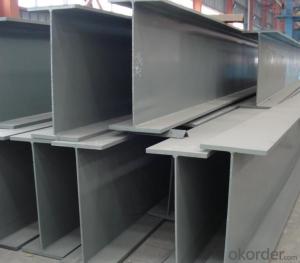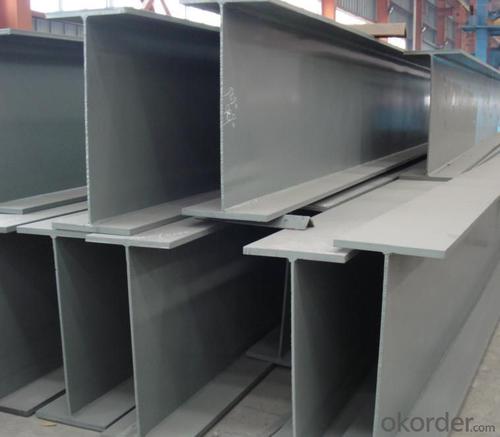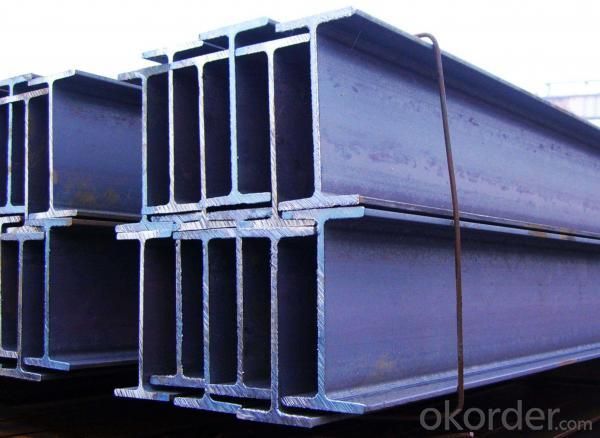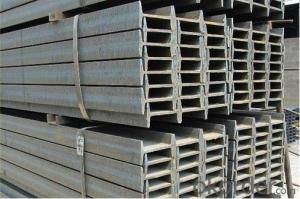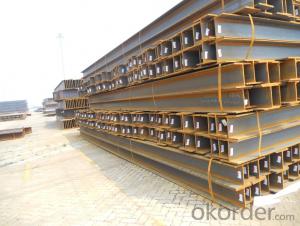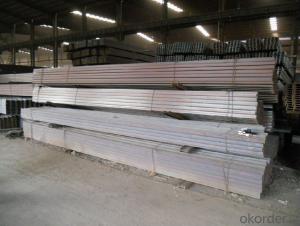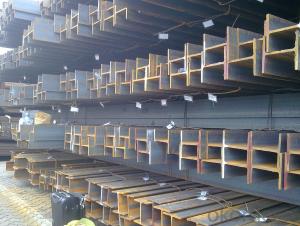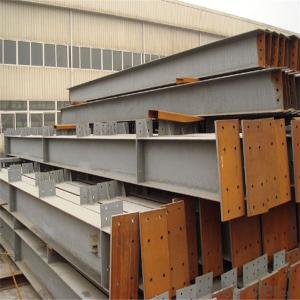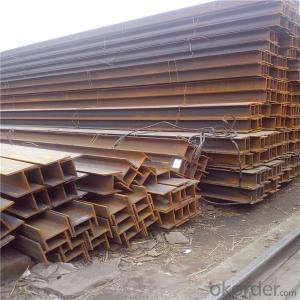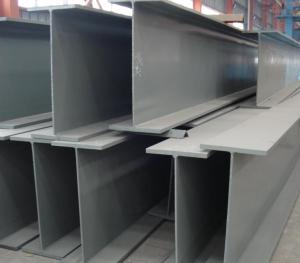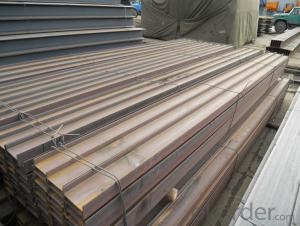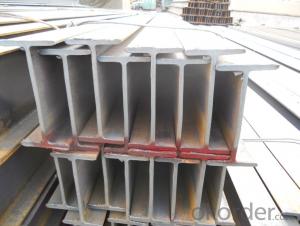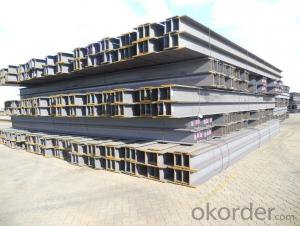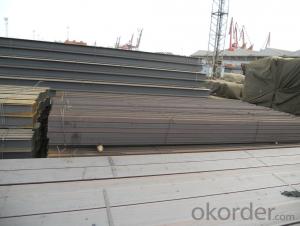Galvanized H Beam with High Quality for Sale
- Loading Port:
- Tianjin
- Payment Terms:
- TT or LC
- Min Order Qty:
- 50 m.t.
- Supply Capability:
- 10000 m.t./month
OKorder Service Pledge
OKorder Financial Service
You Might Also Like
Product Description:
1. Invoicing on theoretical weight or actual weight as customer request
2. Length: 6m, 12m as following table
3. Sizes:Zinc Thickness :15-80μ
Model Number | specification | sectional area | theoretical weight | |||
H*B | t1 | t2 | r | kg/m | ||
100*100 | 100*100 | 6 | 8 | 10 | 21.9 | 17.2 |
175*175 | 175*175 | 7.5 | 11 | 13 | 51.43 | 40.3 |
200*200 | 200*200 | 8 | 12 | 16 | 64.28 | 50.5 |
200*200 | 200*204 | 12 | 12 | 16 | 72.28 | 56.7 |
250*250 | 244*252 | 11 | 11 | 16 | 82.05 | 64.4 |
250*250 | 250*250 | 9 | 14 | 16 | 92.18 | 72.4 |
250*250 | 250*255 | 14 | 14 | 16 | 104.7 | 82.2 |
300*300 | 294*302 | 12 | 12 | 20 | 108.3 | 85 |
300*300 | 300*300 | 10 | 15 | 20 | 120.4 | 94.5 |
300*300 | 300*305 | 15 | 15 | 20 | 135.4 | 106 |
350*350 | 338*351 | 13 | 13 | 20 | 135.3 | 106 |
350*350 | 344*348 | 10 | 16 | 20 | 146 | 115 |
350*350 | 344*354 | 16 | 16 | 20 | 166.6 | 131 |
350*350 | 350*350 | 12 | 19 | 20 | 173.9 | 137 |
350*350 | 350*357 | 19 | 19 | 20 | 198.4 | 156 |
400*400 | 388*402 | 15 | 15 | 24 | 179.2 | 141 |
400*400 | 394*398 | 11 | 18 | 24 | 187.6 | 147 |
400*400 | 394*405 | 18 | 18 | 24 | 215.2 | 169 |
400*400 | 400*400 | 13 | 21 | 24 | 219.5 | 172 |
400*400 | 414*405 | 18 | 28 | 24 | 296.2 | 233 |
400*400 | 400*408 | 21 | 21 | 24 | 251.5 | 197 |
400*400 | 428*407 | 20 | 35 | 24 | 361.4 | 284 |
600*200 | 606*201 | 12 | 20 | 24 | 153.3 | 120 |
700*300 | 692*300 | 13 | 20 | 28 | 211.5 | 166 |
700*300 | 700*300 | 13 | 24 | 28 | 235.5 | 185 |
200*150 | 194*150 | 6 | 9 | 16 | 39.76 | 31.2 |
200*175 | 244*175 | 7 | 11 | 16 | 56.24 | 44.1 |
300*200 | 294*200 | 8 | 12 | 20 | 73.03 | 57.3 |
350*250 | 340*250 | 9 | 14 | 20 | 101.5 | 79.7 |
400*300 | 390*300 | 10 | 16 | 24 | 136.7 | 107 |
450*300 | 440*300 | 11 | 18 | 24 | 157.4 | 124 |
500*300 | 482*300 | 11 | 15 | 28 | 146.4 | 115 |
500*300 | 488*300 | 11 | 18 | 28 | 164.4 | 129 |
600*300 | 582*300 | 12 | 17 | 28 | 174.5 | 137 |
600*300 | 588*300 | 12 | 20 | 28 | 192.5 | 151 |
600*300 | 594*302 | 14 | 23 | 28 | 222.4 | 175 |
Specifications:
Trade Mark | Tensile Test | Impact Test | |||||
Steel Thickness mm | Yield Strength Mpa | Tensile Strength Mpa | Steel Thickness mm | Extensibility
% | Temprature
°C | Impact Energy | |
Q235A | ≤16 | ≥235 |
375-500 | ≤16 | ≥36 | ||
Q235B | >16-40 | ≥225 | >16-40 | ≥25 | 20 | ≥27 | |
QQ235C | >40-60 | ≥215 | >40-60 | ≥24 | 0 | ||
Q345A |
470-630 | ≥21 | |||||
Q345B | ≤16 | ≥345 | ≥21 | 20 | ≥34 | ||
Q345C | >16-35 | ≥325 | ≥22 | 0 | |||
Q235qC | ≤16 | ≥235 |
375-390 | ≥26 | 0 | ||
>16-35 | ≥225 | ||||||
>35-50 | ≥215 | ||||||
Q345qC | ≤16 | ≥345 |
470-510 | ≥21 | 0 | ||
>16-35 | ≥325 | ≥20 | |||||
>35-50 | ≥315 | ≥20 | |||||
SS400 | ≤16 | ≥245 |
400-510 | ≥21 | |||
>5,≤16 | ≥17 | ||||||
>16≤40 | ≥235 | >16,≤50 | ≥21 | ||||
SS490 | ≤16 | ≥285 |
490-610 | ≤5 | ≥19 | ||
>5.≤16 | ≥15 | ||||||
>16≤40 | ≥275 | >16,≤40 | ≥19 | ||||
Packaging & Delivery:
1. Packing: it is nude packed in bundles by steel wire rod
2. Bundle weight: not more than 3.5MT for bulk vessel; less than 3 MT for container load
3. Marks:
Color marking: There will be color marking on both end of the bundle for the cargo delivered by bulk vessel. That makes it easily to distinguish at the destination port.
Tag mark: there will be tag mark tied up on the bundles. The information usually including supplier logo and name, product name, made in
If loading by container the marking is not needed, but we will prepare it as customer request.
4.Transportation: the goods are delivered by truck from mill to loading port, the maximum quantity can be loaded is around 40MTs by each truck. If the order quantity cannot reach the full truck loaded, the transportation cost per ton will be little higher than full load.
5. Delivered by container or bulk vessel
FAQ:
Q1: Why buy Materials & Equipment from OKorder.com?
A1: All products offered byOKorder.com are carefully selected from China's most reliable manufacturing enterprises. Through its ISO certifications, OKorder.com adheres to the highest standards and a commitment to supply chain safety and customer satisfaction.
Q2: How do we guarantee the quality of our products?
A2: We have established an advanced quality management system which conducts strict quality tests at every step, from raw materials to the final product. At the same time, we provide extensive follow-up service assurances as required.
Q3: How soon can we receive the product after purchase?
A3: Within three days of placing an order, we will begin production. The specific shipping date is dependent upon international and government factors, but is typically 7 to 10 workdays.
Images:
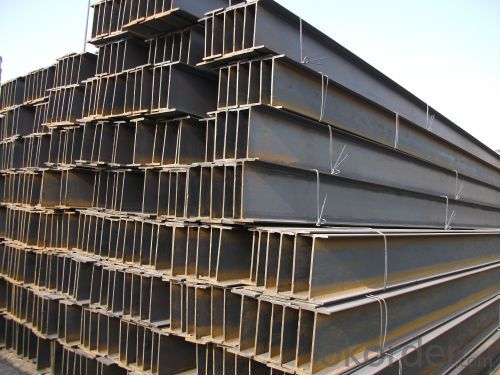
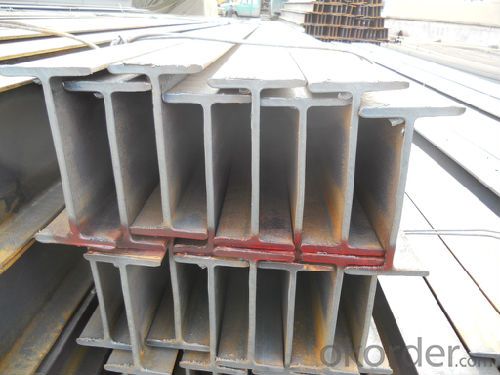
- Q: Are steel H-beams resistant to rot or decay?
- No, steel H-beams are not resistant to rot or decay. Unlike wood, steel does not rot or decay, as it is not an organic material. Steel beams are made from iron with varying amounts of carbon and other elements, which gives them their strength and durability. However, it is important to note that while steel beams are not prone to rot or decay, they can still corrode over time due to exposure to moisture and other environmental factors. To prevent corrosion, steel beams are often coated with protective layers, such as paint or galvanization, which helps to extend their lifespan and maintain their structural integrity.
- Q: Can steel H-beams be used for exhibition halls or convention centers?
- Yes, steel H-beams can be used for exhibition halls or convention centers. Steel H-beams are commonly used in construction due to their high strength and durability. They provide structural support and can withstand heavy loads, making them suitable for large and open spaces like exhibition halls or convention centers. Additionally, steel H-beams can be easily fabricated and customized to meet specific design requirements and can be used to create large-span structures without the need for excessive columns or supports. Overall, steel H-beams are a popular choice for building exhibition halls or convention centers as they offer strength, flexibility, and cost-effectiveness.
- Q: How to control the welding deformation made of H steel
- H steel is a new type of economical construction steel. H type steel cross section shape is reasonable in economy, good mechanical properties, rolling each point on the extended section is uniform, small internal stress, compared with the ordinary beam, a section modulus, light weight, saving advantages of metal, can make the building structure to reduce 30-40%; and because of its inner and outer legs parallel leg end is right, assembled into components, welding, riveting work can save up to 25%. Often used in large capacity requirements, large cross section stability, such as buildings, high-rise buildings, as well as bridges, ships, lifting transport machinery, equipment foundation, support, foundation piles.
- Q: Are steel H-beams resistant to seismic activity?
- Steel H-beams are generally known to be resistant to seismic activity. This is because steel is a highly durable and strong material, making it ideal for withstanding the forces generated during seismic events. H-beams are specifically designed to evenly distribute the load along their length, offering excellent structural support against vertical and lateral movements. Furthermore, steel H-beams are commonly used in earthquake-prone regions due to their superior ability to withstand seismic forces. The flexibility and elasticity of steel allow it to absorb and dissipate seismic energy, minimizing damage caused by ground shaking. Additionally, steel H-beams are often interconnected with other structural elements, such as columns and braces, forming a seismic-resistant system that effectively absorbs and redirects seismic forces. It is important to note, however, that the seismic resistance of steel H-beams can vary depending on factors such as design, construction quality, and adherence to building codes and regulations. To ensure that steel H-beams are appropriately designed and installed to withstand the specific seismic conditions of an area, proper engineering and construction practices must be followed. In conclusion, when designed and constructed properly, steel H-beams provide excellent resistance to seismic activity and are widely utilized in earthquake-resistant building structures.
- Q: What are the different bracing methods for steel H-beams?
- There are several bracing methods for steel H-beams, including lateral bracing, diagonal bracing, and cross bracing. Lateral bracing involves adding bracing members perpendicular to the beam's web to provide support against lateral loads. Diagonal bracing involves adding diagonal members to connect the beam to columns or other structural elements to resist shear and overturning forces. Cross bracing involves adding diagonal members between beams to provide additional stability and prevent lateral movement. These bracing methods are commonly used to enhance the structural integrity and stability of steel H-beams in various construction applications.
- Q: Can steel H-beams be used in museum and art gallery construction?
- Museum and art gallery construction can incorporate steel H-beams for a variety of purposes. These beams possess strength, durability, and versatility, making them a popular choice in construction. They provide structural support and stability, making them suitable for large and intricate architectural designs found in museums and art galleries. Steel H-beams have multiple functions in museum and art gallery construction. They can serve as load-bearing elements, ensuring the building's stability and safety. Additionally, these beams can create spacious interiors and high ceilings, accommodating flexible exhibition layouts and the display of large artworks. Moreover, steel H-beams can contribute to the aesthetic appeal of the museum or art gallery. They can be exposed and integrated into the interior design, aligning with the artistic vision and enhancing the overall atmosphere and ambiance of the space. Furthermore, steel H-beams offer benefits in terms of cost-effectiveness and construction efficiency. They are lightweight, facilitating easier transportation and installation compared to other materials. Furthermore, steel is a recyclable material, aligning with sustainable construction practices. However, it is crucial to consider specific design requirements, load-bearing capacities, and the architectural vision when deciding to incorporate steel H-beams in museum and art gallery construction. Consulting with structural engineers and architects specialized in museum and art gallery construction is necessary to ensure the proper utilization of steel H-beams and the achievement of desired artistic and functional outcomes.
- Q: What are the design considerations for steel H-beam structures?
- Design considerations for steel H-beam structures include: 1. Load-bearing capacity: The primary consideration for any structural design is ensuring that the H-beam structure can support the intended loads. This involves calculating the maximum expected loads, such as dead loads (the weight of the structure itself), live loads (occupant loads and equipment), and environmental loads (wind, snow, seismic forces). The H-beam must be designed to withstand these forces without failure or excessive deflection. 2. Material selection: Choosing the appropriate steel grade is crucial for structural integrity. Different steel grades have varying strength, toughness, and corrosion resistance properties. The selection should be based on the specific requirements of the project, including the expected loads, environmental conditions, and budget constraints. 3. Beam size and shape: Determining the optimal size and shape of the H-beam is essential to achieve the desired structural performance. Factors such as span length, column spacing, and floor-to-floor height impact the selection of beam sizes. Structural engineers perform extensive calculations to find the most efficient and cost-effective beam dimensions that meet the design criteria. 4. Connection design: The connections between H-beams and other structural elements, such as columns or beams, must be carefully designed to ensure load transfer and overall stability. The connection design should consider factors such as load distribution, ease of construction, and maintenance requirements. Common connection methods include welding, bolting, and riveting. 5. Fire protection: Steel is susceptible to heat, and fire protection is a critical design consideration for H-beam structures. Fire-resistant coatings or insulating materials are often applied to the steel members to delay or prevent structural failure during a fire. These fire protection measures should comply with local building codes and fire safety regulations. 6. Architectural integration: In addition to structural considerations, H-beam designs often need to align with architectural requirements. Architects and structural engineers collaborate to integrate the H-beam structure seamlessly into the overall aesthetic and functional design of the building. This may involve hiding or incorporating the beams into architectural elements, such as ceilings, walls, or facades. 7. Sustainability and cost-effectiveness: Designing steel H-beam structures with sustainability and cost-effectiveness in mind is essential. This includes optimizing material usage to minimize waste, considering long-term maintenance and durability, and selecting energy-efficient design solutions. Additionally, the design should aim to minimize the overall cost of the structure while meeting the required performance criteria. Overall, careful consideration of these design factors ensures that steel H-beam structures are safe, durable, and efficient for their intended purposes.
- Q: What is the maximum allowable camber for steel H-beams?
- The maximum allowable camber for steel H-beams is typically specified by the relevant industry standards or project specifications. The specific maximum allowable camber can vary depending on the size, grade, and intended use of the H-beam. It is important to consult these standards or specifications to determine the maximum allowable camber for a specific steel H-beam.
- Q: How do steel H-beams perform in areas with high wind speeds?
- Steel H-beams are known for their exceptional strength and structural integrity, making them an excellent choice for areas with high wind speeds. The unique shape of the H-beam, which resembles the letter "H," provides significant resistance against bending and deflection caused by strong winds. This design allows the beam to efficiently distribute the wind load across its entire length, preventing any localized stress points that may compromise its stability. Additionally, steel is a highly durable and robust material that can withstand extreme weather conditions, including high wind speeds. Unlike other building materials, such as wood or concrete, steel is not prone to warping, rotting, or cracking. This inherent strength and resilience make steel H-beams highly reliable in areas where wind loads are a concern. To further enhance their performance in high wind areas, steel H-beams can be strengthened by using thicker sections or adding additional reinforcement, such as stiffeners or bracing systems. This customization allows the beams to withstand even more significant wind loads, providing an extra layer of safety and stability. Overall, steel H-beams are a trusted choice for buildings in areas with high wind speeds due to their excellent load-bearing capacity, durability, and ability to withstand extreme weather conditions. Their ability to efficiently distribute wind loads and resist bending makes them an ideal solution for maintaining structural integrity and ensuring the safety of buildings and infrastructure in these challenging environments.
- Q: What are the different connection methods used for steel H-beams?
- Steel H-beams can be connected using various methods, depending on the project's specific needs. Some commonly used methods include the following: 1. Welding: Welding is a popular choice for connecting steel H-beams. It involves melting the beam edges and fusing them together using a welding electrode. This method ensures a strong and durable connection, guaranteeing structural integrity. 2. Bolting: Another frequently used method is bolting, which involves securing the beams together using bolts and nuts. This method allows for easy disassembly and reassembly, making it flexible for different construction projects. 3. Riveting: Although less common nowadays, riveting is still occasionally used to connect steel H-beams. It requires drilling holes in the beams and using rivets to secure them. While time-consuming, this method offers a strong and reliable connection. 4. Adhesive bonding: A modern approach is adhesive bonding, which utilizes high-strength adhesives to bond steel H-beams. This method offers advantages like uniform stress distribution and corrosion resistance. However, it requires specialized knowledge and careful implementation. 5. Mechanical connectors: Mechanical connectors, such as shear connectors or moment-resisting connections, are specifically designed for joining steel H-beams. These connectors provide a reliable and efficient means of connection, often using bolts or welds for added strength. Each connection method has its own advantages and considerations, depending on factors like load-bearing requirements, ease of installation, and project timeline. It is crucial to consult with structural engineers and adhere to industry standards and codes when selecting the appropriate connection method for steel H-beams in any construction project.
Send your message to us
Galvanized H Beam with High Quality for Sale
- Loading Port:
- Tianjin
- Payment Terms:
- TT or LC
- Min Order Qty:
- 50 m.t.
- Supply Capability:
- 10000 m.t./month
OKorder Service Pledge
OKorder Financial Service
Similar products
Hot products
Hot Searches
Related keywords
